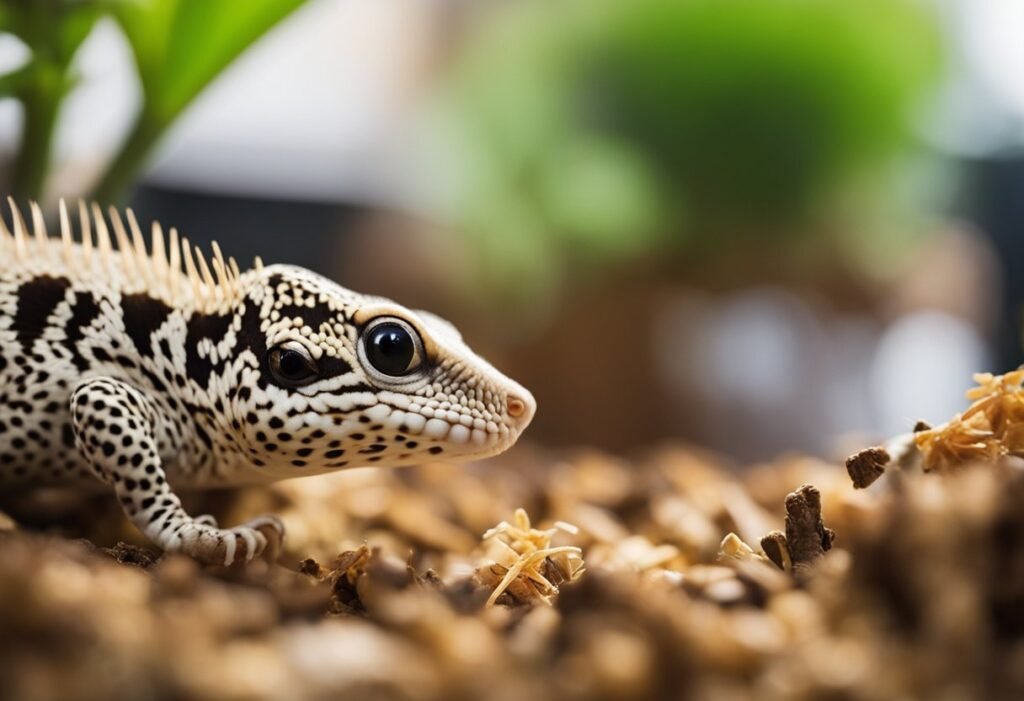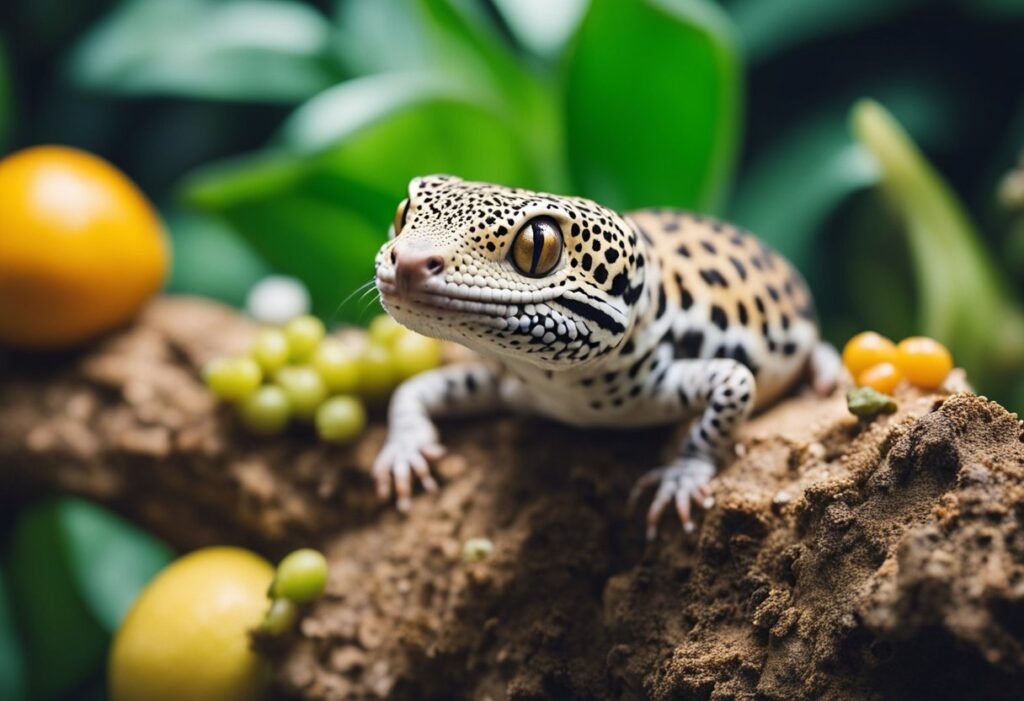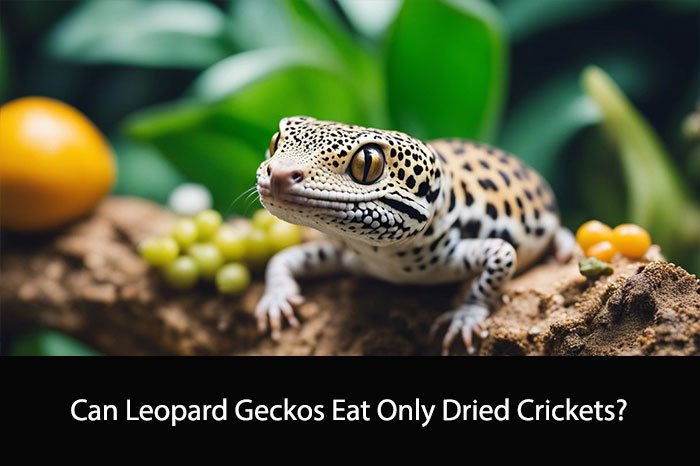Leopard geckos are popular pets that are known for their unique appearance and easy-to-care-for nature. As with any pet, it’s important to provide them with a balanced diet to ensure their health and well-being. One common question that arises among leopard gecko owners is whether or not they can eat only dried crickets.

While dried crickets can be a convenient and affordable option for feeding leopard geckos, it’s important to note that they should not be the sole source of their diet. Leopard geckos require a varied diet that includes a mix of insects, such as crickets, mealworms, and waxworms, as well as occasional treats like fruits and vegetables. A diet that is solely based on dried crickets can lead to nutritional deficiencies and health problems for your gecko.
In this article, we will dive deeper into the topic of whether leopard geckos can eat only dried crickets. We will explore the nutritional requirements of leopard geckos, the benefits and drawbacks of feeding them dried crickets, and offer tips on how to create a balanced diet for your pet. By the end of this article, you will have a better understanding of how to properly feed your leopard gecko and ensure their long-term health and happiness.
Leopard Gecko Dietary Basics

Leopard geckos are insectivores, which means they eat mainly insects. In the wild, they feed on a variety of insects, such as crickets, mealworms, waxworms, and roaches. In captivity, it’s important to provide them with a balanced diet that meets their nutritional needs.
Nutritional Needs
Leopard geckos require a diet that is high in protein and low in fat. They also need a good source of calcium and other essential vitamins and minerals. Dried crickets can be a good source of protein for leopard geckos, but they should not be the only food in their diet. It’s important to offer a variety of insects to ensure they receive all the nutrients they need.
In addition to insects, leopard geckos also require a source of calcium. Calcium is essential for their bone health and helps prevent metabolic bone disease. You can provide calcium by dusting their food with a calcium supplement or offering them calcium-rich foods, such as calcium-fortified insects or calcium powder.
Feeding Frequency
Leopard geckos should be fed every 1-2 days, depending on their age and size. Juvenile geckos require more frequent feedings than adults. It’s important not to overfeed them, as this can lead to obesity and other health problems. You can determine how much to feed them by offering them a few insects at a time and monitoring their weight.
In conclusion, dried crickets can be a good source of protein for leopard geckos, but they should not be the only food in their diet. It’s important to provide them with a balanced diet that meets their nutritional needs, including a variety of insects and a source of calcium. Feeding frequency should also be monitored to ensure they are not overfed.
Dried Crickets as a Food Source

When it comes to feeding leopard geckos, there are many options available. One commonly used food source is dried crickets. In this section, we will discuss the pros and cons of using dried crickets as a food source, as well as how to properly prepare and store them.
Pros and Cons of Dried Crickets
Dried crickets are a convenient food source for leopard geckos. They are readily available at most pet stores and can be purchased in bulk. Dried crickets are also easy to store and have a long shelf life, making them a cost-effective option.
However, there are some downsides to using dried crickets as a sole food source for leopard geckos. Firstly, they lack the moisture content that live insects provide, which can lead to dehydration if not supplemented with water. Additionally, dried crickets may not provide the same nutritional value as live insects, as they may lose some of their nutrients during the drying process.
Preparation and Storage
When feeding dried crickets to leopard geckos, it is important to properly prepare and store them. Before feeding, soak the crickets in water for at least 10 minutes to rehydrate them. This will help prevent dehydration in your gecko.
To store dried crickets, keep them in a cool, dry place away from direct sunlight. It is also important to check the expiration date on the package and discard any expired crickets.
In conclusion, while dried crickets can be a convenient and cost-effective food source for leopard geckos, they should not be the sole source of nutrition. It is important to supplement with other live insects and ensure that your gecko has access to fresh water. Proper preparation and storage of dried crickets is also crucial for your gecko’s health.
Variety in Diet

Importance of Diet Variation
As leopard gecko owners, we want to ensure that our pets are healthy and happy. One way we can do this is by providing them with a varied diet. While dried crickets are a popular food option for leopard geckos, it is important to remember that they should not be the only food item in their diet.
By providing a variety of foods, we can ensure that our geckos receive all the necessary nutrients they need to thrive. Just like humans, leopard geckos require a balanced diet to stay healthy. A varied diet can also help prevent boredom and encourage natural feeding behaviors in our pets.
Alternative Food Options
If you’re looking to add some variety to your leopard gecko’s diet, there are many alternative food options available. Some of these include:
- Mealworms: These are a good source of protein and can be easily found at most pet stores.
- Dubia Roaches: These roaches are a great alternative to crickets and are high in protein and calcium.
- Waxworms: These are high in fat and should only be fed as a treat, but they can be a good source of variety in your gecko’s diet.
- Silkworms: These are a great source of protein and are high in calcium, making them a healthy addition to your gecko’s diet.
It is important to remember to always feed your gecko appropriately sized prey items to prevent choking or digestive issues. Additionally, make sure to rotate the food items in your gecko’s diet to ensure they receive a balanced diet.
By providing a varied diet, we can ensure that our leopard geckos are healthy and happy. While dried crickets can be a good food option, they should not be the only item in their diet. Consider adding some variety to your gecko’s diet with alternative food options.
Health Considerations
Risks of a Monotonous Diet
As with any pet, it is important to provide a varied diet for leopard geckos. Feeding them only dried crickets can lead to a lack of essential nutrients and vitamins that their bodies need to function properly. This can result in health problems such as metabolic bone disease, which is caused by a lack of calcium and vitamin D3.
Additionally, a diet consisting solely of dried crickets can lead to digestive issues, as they are low in moisture and can cause dehydration if not supplemented with enough water. This can lead to constipation and other digestive problems.
Signs of Nutritional Deficiencies
It is important to monitor your leopard gecko’s health and behavior to ensure they are receiving a balanced diet. Signs of nutritional deficiencies can include lethargy, weight loss, and a lack of appetite. In severe cases, they may develop physical deformities or bone fractures due to a lack of calcium.
To prevent these issues, it is recommended to supplement your leopard gecko’s diet with a variety of insects, such as mealworms, waxworms, and dubia roaches, as well as fresh fruits and vegetables. This will ensure that they receive all the necessary nutrients and vitamins to maintain their health and wellbeing.
In conclusion, while dried crickets can be a part of a leopard gecko’s diet, it is important to provide a varied diet to prevent nutritional deficiencies and health problems. By monitoring their behavior and supplementing their diet with a variety of insects and fresh foods, we can ensure that our leopard geckos live happy and healthy lives.
Feeding Techniques
Hydration and Feeding
As leopard geckos are desert creatures, they have adapted to survive in arid environments. Therefore, it is important to ensure that they have access to water at all times. A shallow dish of water should be provided in their enclosure, and it should be changed daily. In addition to this, leopard geckos should be misted with water once a day to help them stay hydrated.
When it comes to feeding, leopard geckos can be picky eaters. It is important to offer a variety of food to ensure that they are getting all the necessary nutrients. Dried crickets can be a good source of protein, but they should not be the only food offered to leopard geckos. Variety is key, and we recommend offering a mix of live insects such as mealworms, waxworms, and dubia roaches.
Supplementing Dried Crickets
If dried crickets are the only food available, it is important to supplement them with calcium and vitamin D3. Leopard geckos require these nutrients to maintain healthy bones and prevent metabolic bone disease. Dusting the dried crickets with a calcium and vitamin D3 supplement before feeding can help ensure that leopard geckos are getting the necessary nutrients.
It is important to note that over-supplementing with vitamin D3 can be harmful to leopard geckos. We recommend following the instructions on the supplement packaging and consulting with a veterinarian if you have any concerns.
In conclusion, while dried crickets can be a part of a leopard gecko’s diet, they should not be the only food offered. Variety is important, and supplementing with calcium and vitamin D3 is necessary to maintain a healthy diet.
Frequently Asked Questions
What alternative food sources can we provide for our leopard gecko?
In addition to dried crickets, leopard geckos can also eat live crickets, mealworms, superworms, and waxworms. It’s important to vary their diet to ensure they receive a balance of nutrients.
Are dried insects nutritionally adequate for leopard geckos?
While dried insects can be a convenient option, it’s important to note that they may not be as nutritionally complete as live insects. Dried insects also lack moisture, which can lead to dehydration in leopard geckos. We recommend offering a mix of both dried and live insects.
Is it safe for leopard geckos to consume freeze-dried mealworms?
Freeze-dried mealworms can be a safe and convenient option for leopard geckos. However, it’s important to make sure they are not the only food source offered, as they may not be as nutritionally complete as live insects.
Do leopard geckos require live food in their diet?
Yes, leopard geckos require live food in their diet to ensure they receive the necessary nutrients and stimulation. Live insects also provide enrichment for leopard geckos, as they enjoy the challenge of hunting and catching their food.
How often should leopard geckos be fed insects?
Leopard geckos should be fed insects every 1-2 days, depending on their age and size. Adult leopard geckos may only need to be fed every 2-3 days.
What are the risks of feeding mealworms to leopard geckos?
Mealworms can be a good food source for leopard geckos, but they should not be the only food offered. Mealworms have a hard exoskeleton that can be difficult for leopard geckos to digest, and they also have a high fat content. Overfeeding mealworms can lead to obesity and other health issues in leopard geckos.





